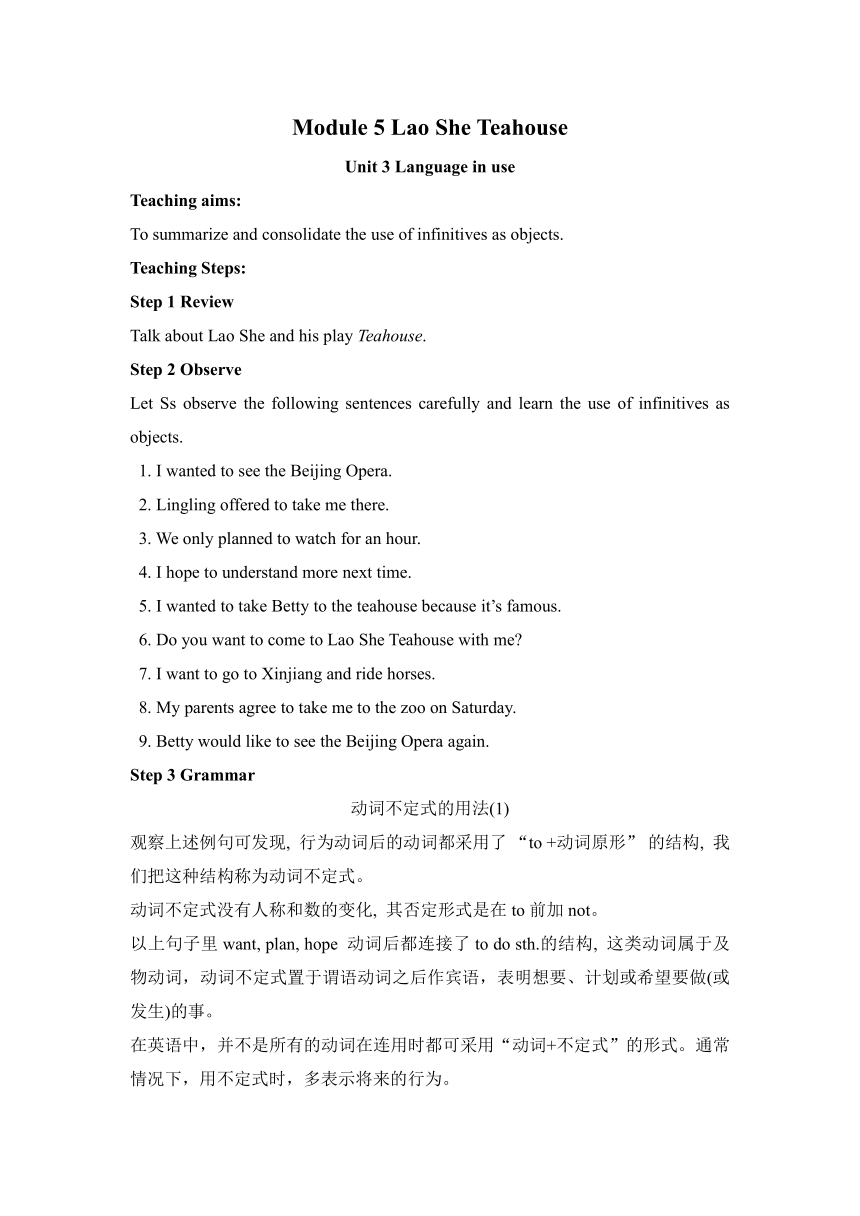
Module 5 Lao She Teahouse Unit 3 Language in use Teaching aims: To summarize and consolidate the use of infinitives as objects. Teaching Steps: Step 1 Review Talk about Lao She and his play Teahouse. Step 2 Observe Let Ss observe the following sentences carefully and learn the use of infinitives as objects. 1. I wanted to see the Beijing Opera. 2. Lingling offered to take me there. 3. We only planned to watch for an hour. 4. I hope to understand more next time. 5. I wanted to take Betty to the teahouse because it’s famous. 6. Do you want to come to Lao She Teahouse with me 7. I want to go to Xinjiang and ride horses. 8. My parents agree to take me to the zoo on Saturday. 9. Betty would like to see the Beijing Opera again. Step 3 Grammar 动词不定式的用法(1) 观察上述例句可发现, 行为动词后的动词都采用了 “to +动词原形” 的结构, 我们把这种结构称为动词不定式。 动词不定式没有人称和数的变化, 其否定形式是在to前加not。 以上句子里want, plan, hope 动词后都连接了to do sth.的结构, 这类动词属于及物动词,动词不定式置于谓语动词之后作宾语,表明想要、计划或希望要做(或发生)的事。 在英语中,并不是所有的动词在连用时都可采用“动词+不定式”的形式。通常情况下,用不定式时,多表示将来的行为。 常见的后面接动词不定式作宾语的动词有:hope, decide, want, try, offer, learn, love, like, agree, plan等。 Step 4 Practice 用括号内单词的适当形式填空。 1. The villagers plan _____ (build)a new bridge over the river. 2. —What will you do with these old clothes —I want _____ (send) them to children in poor areas. 3. Barry is very tired and he needs _____ (get) some sleep. 4. Andy loves Chinese history and he chooses _____ (go) to college in China. 5. Mr Miller offered _____ (give) us a ride. What a nice man he is! Step 5 Observe Let Ss observe the following sentences carefully and pay attention to the words in red. 1. It tells us the story of Wang Lifa and the customers of his teahouse in Beijing. 2. Lao She Teahouse gives a warm welcome to everyone from all over the world. 3. Our teacher told us a story. 4. The sun gives us light and warmth. 5. My parents bought me a computer. 6. Give me a cup of tea, please. 7. She passed the salt to him. 以上句子中都出现了两个动作的承受者,一个是物,一个是人。请找出这两类不同的宾语,并观察它们是如何排列的。 Step 6 Grammar 英语中有些及物动词后可以接两个宾语,即指人的间接宾语和指物的直接宾语,这两个宾语称为“双宾语”。 双宾语有两种结构: 1) 及物动词+间接宾语+直接宾语 (及物动词+人+物) e.g. tell us the story 2) 及物动词+直接宾语+介词to/for+间接宾语 (及物动词+物+介词to/for+人) e.g. give a warm welcome to everyone 可以接双宾语的动词有很多,常见的有: give, bring, lend, pass, send, show, leave, buy, tell, teach, sell等。 e.g. My brother bought me some storybooks. My brother bought some storybooks for me. My uncle gave me a pretty birthday present. Can you pass me that pencil Who teaches you English Waiters bring tea to the customers. 其他常用的结构: cook sb. sth. = cook sth. for sb. send sb. sth. = send sth. to sb. give sb. sth. = give sth. to sb. show sb ... ...
~~ 您好,已阅读到文档的结尾了 ~~

